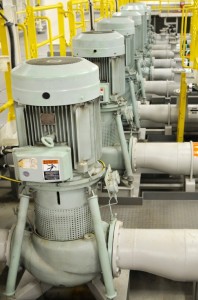In the modern industrial age, pumps have become ever present in our daily lives. From the simple and mundane task of filling your car with gas, to the crucial task of dialysis for people suffering from kidney failure, pumps are essential to the modern lifestyle.
As there are many different applications that pumps are used for, there are many different styles of pumps, but all pumps fall under one of two classifications. The two classifications of pump are positive displacement and centrifugal. The positive displacement pump delivers a set amount of fluid for each stroke or rotation, while the centrifugal pump can deliver various amounts of fluid at a given speed. There is also a wide range of pump sizes available which are capable of miniscule dispensing rates to millions of gallons per minute. Pumps are rated by their discharge pressure and flow rate in gallons per minute.
As the pressure, speed, and volume of fluid that a pump can move can be very dangerous, it essential that the appropriate pump is selected for each particular application. Always refer to the manufacturer specifications and recommended operations when selecting a pump for your application.
Positive displacement pumps come in many different styles and are either rotary or reciprocating motion. A few examples of the reciprocating style are piston-style and a diaphragm-style which use a back and forth motion to provide the motive force to the fluid. The rotary-style such as gear pumps and lobe pumps use a rotating action to impart motion. All positive displacement pumps move a given amount of fluid per rotation or stroke due to their design which limits slip, and therefore it is always recommended that a pressure relief valve be placed on the outlet to prevent over-pressurization of the system.
Centrifugal pumps are the most common style of pumps used in the industrial environment today. They are favored for their ability to handle pressure and flow variances due to system demand. The slip provided by the centrifugal pump design allows fluid to leak back from the discharge to the suction. Centrifugal pumps consist of an impeller mounted on a shaft and driven by a motor. The suction of the pump is in the center of the impeller and as the impeller spins the centrifugal force imparted on the fluid pushes it to the outside of the casing and out of the discharge.
This is a very brief and general overview, but I hope it helps you understand some of the basics of pumps.
Article created by Seth Kohler, Subject Matter Expert at TTS.
To learn more view our latest video, Pumping System Arrangements.


